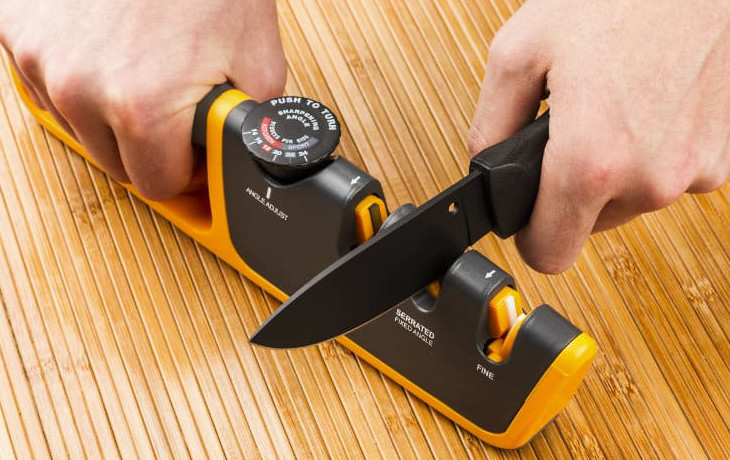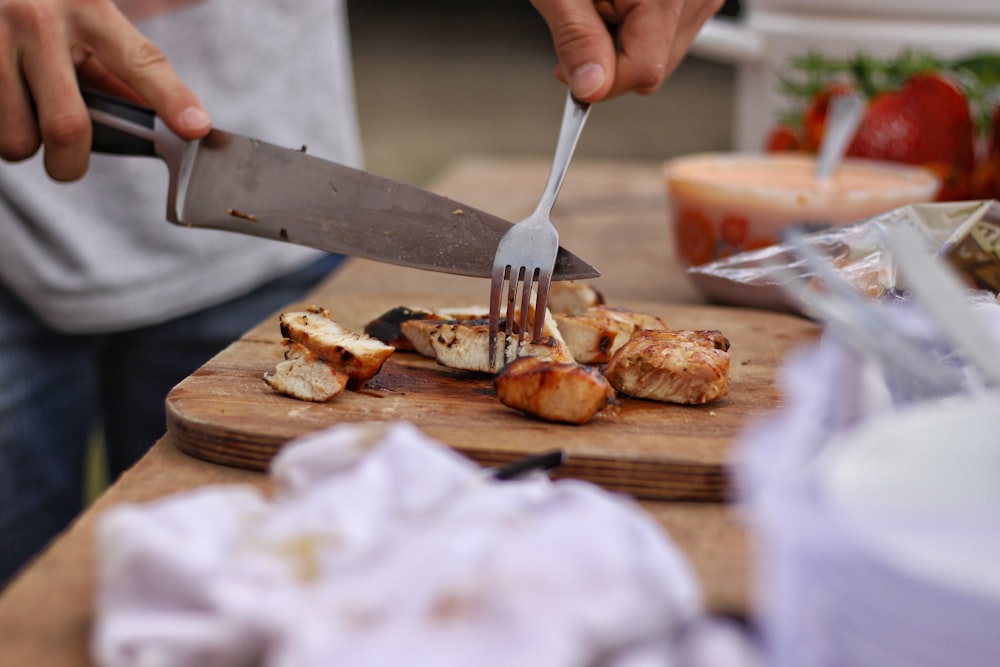A sharp knife is any cook’s best friend. Dull knives are more dangerous than sharp knives because they require more pressure to cut through food, leading to slips and accidents. A pull-through knife sharpener is an easy way to keep your knives sharp without having to take them to a professional.
A pull-through knife sharpener is a simple, easy-to-use tool for sharpening knives. The sharpener consists of a cylindrical grinding wheel and a honing guide. There are many different pull-through knife sharpeners on the market, but they all work in basically the same way.
Learn how to use a pull-through knife sharpener in this article.
How Do Pull Through Knife Sharpeners Work?

Photo Credit: The Prepared
Pull through knife sharpeners work by grinding away the blade of the knife. The grinding wheel is coated with a fine abrasive that grinds away the knife’s blade. The more passes you make, the sharper the knife will be.
Some pull-through knife sharpeners also have a honing guide. The honing guide helps keep the knife at the correct angle while you are sharpening it. It is essential because it will not be as sharp as possible if the knife is not sharpened at the right angle.
Abrasive: diamond or ceramic?
There are two types of abrasives used in pull-through knife sharpeners: diamond and ceramic. Diamond is the sharper of the two, but it also wears down faster. Ceramic is not as sharp as diamond, but it lasts longer.
Most pull-through sharpeners have ceramic sharpening stones, but some have diamond sharpening stones. If your knife is dull, you should start with the diamond sharpening stone because it will sharpen the knife more quickly. If your knife is only slightly dull, you can use the ceramic sharpening stone to get a sharper and more polished edge.
How to Use A Pull Through Knife Sharpener

Photo Credit: Home Stratosphere
Sharpening your dull knife with a pull-through knife sharpener is simple. Just follow these steps:
🔪Use the coarse setting.
If you need to reshape a very blunt knife, use the coarse setting on the grinding wheel. Most manual sharpeners have at least two different settings: coarse and fine. Coarse is for reshaping the blade, and fine is for polishing the edge.
Coarse will eliminate metals from the blade, so it is essential only to use this setting if the knife is very dull and needs reshaping. You can use the fine setting for maintaining the sharpness of the blade.
🔪Insert the blade into the sharpener.
Insert the knife’s blade into the sharpener from its base, where the blade is close to the handle. Gently push the blade down into the sharpener so that the grinding wheel makes contact with the edge.
🔪Move the knife back and forth.
Pull the knife through the slot towards you, then push it away. Move it back and forth three to six times. Be careful not to apply too much pressure, as this can damage the blade. Do not apply too much pressure. Let the weight of the knife do the work. Make sure to keep the angle of the knife consistent as you move it back and forth.
Use enough force as you pull the knife back so that the grinding wheel makes contact with the blade, and you’ll hear a grinding sound. If you don’t hear a grinding noise, you’re not using enough pressure.
🔪Move the knife base on the curve of the blade wheel.
When sharpening the blade, you should move the knife base on the curve of the blade wheel. It will help to keep the angle of the blade consistent. It will also ensure that the entire blade gets sharpened.
If you’re pressing down, you will determine that you’re moving it correctly by the grinding noise. If you’re not hearing the noise or feel any resistance, you might be holding the knife at an angle not contacting the grinding wheel.
🔪Check the sharpness of the knife.
Once you have moved the knife back and forth a few times, check the sharpness of the blade by trying to cut through a piece of paper. If it doesn’t cut easily, move the knife back and forth a few more times.
🔪Use the fine setting.
After making some runs on the coarse setting, run the blade through the fine setting to give a few final strokes for a clean and refined edge. You don’t need to use too much pressure on the fine setting.
🔪Rinse the knife.
After sharpening the blade, rinse the knife with water to remove any metal particles that may have been removed from the edge. Use warm water and dishwashing soap to clean the sharpener.
Make sure to dry the knife and sharpener before storing them. It will prevent the build-up of rust. You can use a dish towel to dry and clean any leftover particles from the blade.
Keep in mind not using the dishwasher to clean the knife sharpener. It will damage the sharpener by getting banged into other dishes and utensils.
Benefits of Using A Pull Through Knife Sharpener

There are many benefits to using a pull-through knife sharpener. If you’re not yet convinced why using this manual sharpener is a good idea, consider the following:
💙Easy to use
The pull-through knife sharpener is one of the easiest sharpeners to use. All you have to do is insert the blade, move it back and forth a few times, and then check the sharpness. You don’t need any prior experience or skills to use this sharpener.
💙It’s portable
The knife sharpener is small and portable, so you can take it with you wherever you go. It is an excellent option if you’re someone who likes to cook outdoors or on the go.
💙Excellent for home use
The knife sharpener is also great for home use. It doesn’t take up a lot of space, so you can keep it in your kitchen without having to worry about it taking up too much counter space.
💙It’s affordable
The knife sharpener is also very affordable, so it’s a great option if you’re looking for an affordable way to keep your knives sharp.
💙Safe to use
The knife sharpener is also safe to use. There are no blades or other dangerous components, so you don’t have to worry about getting injured while using it.
💙Easy to clean
The knife sharpener is also easy to clean. You have to rinse it with water and use dishwashing soap to clean it. You don’t need any special tools or equipment to clean it.
What Are Other Sharpening Methods?

If the pull-through knife sharpener doesn’t appeal to you, or if you’re looking for other sharpening methods, consider the following:
👉Stone sharpener
A stone sharpener is a popular option for sharpening knives. It uses two stones – a coarse and fine stone – to sharpen the blade. The benefit of using a stone sharpener is that you can get a more precise edge.
However, using a stone sharpener can be tricky, and it takes some practice to get the hang of it. It would help if you also use the correct angle when sharpening the blade. If you’re not careful, you can easily damage the knife.
👉Electric knife sharpener
An electric knife sharpener is an excellent option if you want to quickly and easily sharpen your knives. It’s almost the same as a manual sharpener with a coarse and fine setting, but it’s powered by electricity.
It uses spinning blades to sharpen the blade. It can be easy to over-sharpen the edge with the electric knife sharpener, damaging the knife. The downside of using an electric knife sharpener is that it can be expensive. They can also be bulky, so they may not be the best option if you’re looking for a portable sharpener.
👉Manual knife sharpener
A manual knife sharpener is another option for sharpening your knives. It’s a simple tool that has a coarse and fine setting. You use the coarse setting to remove the blade’s dull edge and then use the fine setting to polish it.
A manual knife sharpener is an excellent option if you’re looking for an affordable and portable sharpener. Also, a pull-through knife sharpener is a type of manual sharpener. It is an excellent option for those looking for an affordable, easy-to-use, and portable sharpener. It’s a perfect choice for those new to sharpening knives or those who want a quick and easy way to sharpen their knives.
Frequently Asked Questions
Q: Are pull-through sharpeners any good?
A: Yes, pull-through sharpeners are an excellent option to sharpen your dull knives. If your priority is speed and convenience, a pull-through sharpener is a great choice.
Q: Can I sharpen a serrated knife with a pull-through sharpener?
A: Yes, you can sharpen a serrated knife with a pull-through sharpener. However, it may be challenging to get a precise edge on the serrated knife. Use the fine setting on the sharpener and go slowly to achieve the best results.
Q: What type of knives can I sharpen with a pull-through sharpener?
A: You can sharpen most types of knives with a pull-through sharpener, including kitchen knives, hunting knives, and pocket knives. However, you may have difficulty sharpening a cleaver with a pull-through sharpener.
Q: Is it safe to use a pull-through sharpener?
A: Yes, it is safe to use a pull-through sharpener. There are no blades or sharp components, so you don’t have to worry about getting injured while using it.
Q: How often should I sharpen my knives?
A: How often you need to sharpen your knives depends on the type of knife, how often you use it, and the blade type. However, it would be best to sharpen most knives every 4-6 months.
Q: How much does a pull-through sharpener cost?
A: A pull-through sharpener typically costs around $6-20. It is an excellent option if you’re looking for an affordable way to keep your knives sharp. Some brands go as expensive as $120.
Final Thoughts
Having a dull knife can make cooking and other tasks much more difficult. If your knife is mashing the ingredients instead of slicing them, it’s time to sharpen those blades. A pull-through sharpener is a great, affordable option for those who want an easy way to keep their knives sharp.
It’s a simple tool that has two settings – coarse and fine. You use the coarse setting to remove the blade’s dull edge and then use the fine set to polish it. A pull-through sharpener is an excellent option for those looking for an affordable and portable sharpener. So, if your knives need a little TLC, consider using a pull-through sharpener to get them back into shape.
